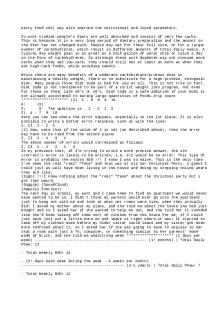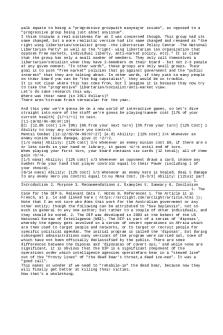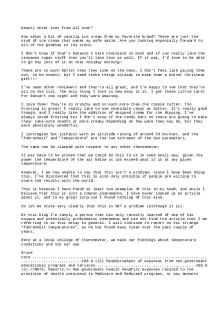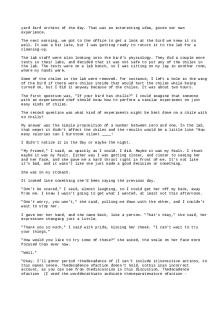Soundtrack Analysis PDF

| Title | Soundtrack Analysis |
|---|---|
| Author | Maia Mintzberg |
| Course | Special Topics in Fine Arts |
| Institution | Concordia University |
| Pages | 3 |
| File Size | 93.3 KB |
| File Type | |
| Total Downloads | 91 |
| Total Views | 142 |
Summary
Soundtrack Analysis...
Description
Introduction: Ron Howard’s, A Beautiful Mind, epitomizes the theme of perseverance. The film, based on a true story, follows schizophrenic mathematical genius, Dr. John Nash, over the course of his adult life. Howard’s vision of the film generates a goodness in Dr. Nash, motivating not only the characters of the film, but the viewer as well. As Alicia says in Dr. Nash’s darkest hour, it inspires people “to believe that something extraordinary is possible”. The role of Dr. John Nash and his wife, Alicia, are played by Russell Crowe and Jennifer Connelly. The two actors share incredible chemistry throughout the film, provoking empathy in the viewer. Crowe embodies a man whose mind gave him everything before betraying him. He brings the character of Dr. Nash to life through his attention to behavioural detail. Throughout the film, the score, written by James Horner, is used to play narrative, relational, and functional aspects, allowing the viewer to sympathize with the tremendous upheaval Dr. Nash’s illness causes. The central narrative surrounding Dr. Nash drives the plot of the film forward, demonstrating a mix of positive and negative qualities Part I: Narrative Analysis The story behind the film, A Beautiful Mind, is structured according to modern narrative principles. This distinction derives from several observations: firstly, from the antagonists that the main characters confront. They, as well as the problems they present, are not incisive. In other words, the problems presented by the antagonists are not clearly evil. Secondly, the main character, Dr. Nash, confronts true-to-life crises, unlike those of a classical narrative. Lastly, through the element of alienation throughout the film. Dr. Nash’s schizophrenic diagnosis causes ambiguity and unhappiness for the viewer. In sum, A Beautiful Mind, is constructed of a modern narrative because the viewer is unable to discern between central and peripheral elements of the story. When analyzing A Beautiful Mind in terms of central and peripheral elements, the viewer is often unable to distinguish between ‘good’ and ‘bad’ due to ambiguity. However, there are scenes throughout the film where central elements of the narrative are clearly ‘good’. For example, when the score, Creating ‘Governing Dynamics’, plays while Dr. Nash finds his unique idea. In this scene, Dr. Nash’s beautiful mind is at work, and the central elements at play are undoubtedly ‘good’. A second example of a clearly ‘good’ central element occurs as Dr. Nash has his second revelation of the film. The score, Cracking the Russian Codes, plays as Dr. Nash experiences a breakthrough in his research for William Parcher. Conversely, there are also central elements of the narrative that are clearly ‘bad’. For instance, when John’s paranoia over the Russians sets in and he realizes that it is unsafe for Alicia to stay with him. The score, Alicia Discovers Nash’s Dark World, plays and it is clear that the central elements at play are distinctly ‘bad’. Interpretation between ‘good’ and ‘bad’ peripheral elements of the narrative are much more difficult to discern. The first peripheral element introduced in the narrative is when Dr. Nash’s roommate, Charles, arrives at Princeton University. Upon Charles’ arrival, Dr. Nash is in his dorm room listening to a record on his player while watching students through his window. Charles barges in and turns off the record player, causing an eerie fade. At this moment, the viewer is faced with ambiguity and wonders whether this peripheral element is ‘good’ or ‘bad’. A second example occurs following Dr. Nash’s hospitalization. Alicia decides that it is time to see the research her husband has been working on. Upon entering his office, the score, Alicia
Discovers Nash’s Dark World, plays for a second time. The viewer experiences a sense of confusion, and is left wondering what the chaos in Dr. Nash’s office means. The peripheral elements featured in the film further prove that A Beautiful Mind is a modern narrative by demonstrating ambiguity throughout the story. Part II: Sound-Image Relational Analysis The film, A Beautiful Mind, is partly composed of a diegetic, parallel sound-image relation. In about 50% of the film, sound and image are in sync, and reinforce one another. Examples of parallel relations can be found throughout the film, for example, in October 1954, when Dr. Nash and Parcher, one of his schizophrenic hallucinations, are caught in a high-speed car chase. In this scene, diegetic sounds of the car chase are amplified. The viewer hears the sounds of wheels skidding on pavement, gunshots being fired back and forth, and splashes when the Russian car drives into the water. A second example of parallel relation in the film occurs when Dr. Nash receives his first round of insulin shock therapy at the psychiatric hospital. Sound and image are in sync as the viewer hears the sounds of Dr. Nash’s heavy breathing, teeth chattering, and shackles shaking. The parallel sound-image relations in the film are used to stimulate the viewer’s receptivity by drawing attention to the scene. The remainder of the soundtrack, about 50%, is comprised of non-diegetic sound, made up of leading and synergistic functions. Examples of these can be found throughout the film, for instance, when sound defines picture in the introduction. The central narrative plays as the opening credits are shown, until the scene settles at Princeton University. This leading function is used to create anticipation and excitement for the viewer. A second example is found when Dr. Nash and Alicia share their first kiss. The diegetic sounds of the outdoors fades, as First DropOff, First Kiss consumes the scene. In this scene, both sound and video work together to amplify the impact of one another, creating synergy. In considering the film as a whole, non-diegetic sound-image relations featured are used to create anticipation for the viewer and emphasize scenes. Throughout the film, two major elements were used to shape the narrative: music and sound effects. A dominant sound-image relation featured in the film is that of synergy. The narrative was shaped each time the soundtrack and video worked together. Synergizing sound and video creates intrigue for the viewers, and allows them to partake in the emotions of the scene. Examples of this can be found whenever the soundtrack plays throughout the film, as the score is used to amplify the impact of the scene. For example, the score playing when Dr. Nash is brought to the Pentagon, or, when he is shackled to the bed at the psychiatric hospital. When analyzing sound effects throughout the film, the viewer must acknowledge that most of the soundtrack that is designed to be synchronous with the character’s actions is created in post-production. Sound effects are added to provide the scenes with a sense of realism. An example of the power of sound effects comes from the scene where Alicia visits Dr. Nash in the psychiatric hospital, and he confesses to the ‘secrets’ he has been keeping from her. The rest of the room falls silent, and the viewer hears the echoes of Dr. Nash and Alicia’s voices as they bounce through the room. A second example demonstrating the ability of sound effects occurs during Alicia’s discovery of Dr. Nash’s secret cabin. As she steps outside to collect their laundry, a storm begins to settle. Alicia hears a radio coming from the forest behind their house, and as she begins to follow it, the radio grows louder. As she walks through the woods, the viewer hears her footsteps through the foliage and the sound of lightening. The addition of these post-
production sound effects are used to shape the narrative according to its central and peripheral elements. Part III: Functional Analysis Throughout the film, A Beautiful Mind, functions of sound are used to facilitate changes of time and place within the story as well as to create an atmosphere within scenes. Changes in time and place are found throughout the film, seeing as it covers a span of 47 years and is spent in a number of locations. The first example of sound creating a change in time and place follows Dr. Nash’s celebration of the completion of his research at Princeton University. Sound anticipates picture, and the viewer sees Dr. Nash arrive at the Pentagon, six years later. The second example occurs following Dr. Nash’s treatment in the psychiatric hospital; sound lags, and the viewer is brought to Princeton University, one year later. The final example of a change in time and place within the story takes the viewer to March 1994, when Dr. Nash, now an old man, is teaching at Princeton University. A second function of sound that is consistent throughout the film is that of emphasizing, intensifying, and setting the pace of action. As the story of Dr. Nash unfolds, his schizophrenic hallucinations become more severe. When analyzing dialogue throughout the film, the viewer must distinguish between what is real, and what is simply part of Dr. Nash’s schizophrenic hallucinations. Examples of these hallucinated instances are found throughout the film, for instance, following his guest lecture at Harvard University. Dr. Nash wakes up from a drug induced haze in Dr. Rosen’s office, only to see a guilt-stricken Charles sitting in the corner. Dr. Nash breaks down, screaming at his hallucinated former roommate, intensifying the scene. A second example of this function of sound occurs after Alicia discovers her husband’s cabin behind their home, and realizes that he has gone off his medication. As Alicia reaches for the phone to call Dr. Rosen, Charles, Parcher, and Marcee appear to Dr. Nash. Throughout this chaotic scene, Alicia Discovers Nash’s Dark World plays for a third time as Dr. Nash struggles to discern between his hallucinations and reality. In this scene, sound is used to emphasize, intensify, and set the pace of action. Part IV: Other Observations In the film, A Beautiful Mind, the consistent use of music throughout the story links to the fourth period of soundtrack history, the romantic period. The romantic period is marked by an overpowering amount of intensity and expression, as demonstrated throughout the film’s score. Interestingly, the film’s soundtrack composer, James Horner, created the score specifically to be performed by the then 15-year-old artist, Charlotte Church. According to an interview he did when the film was released, Horner wanted the vocals of the score to be evocative of being midway between a girl and a woman. Conclusion: To conclude, throughout the film, A Beautiful Mind, the soundtrack is used to relay narrative, relational, and functional aspects. These three aspects, used within the modern narrative film, allow the viewer to empathize with the upheaval Dr. Nash’s mental illness causes, both for him, and his loved ones. The romantic era soundtrack allows the viewer to sympathize with the challenges faced by the characters through the use of central and peripheral elements which, overall, demonstrate a mix of positive and negative qualities....
Similar Free PDFs

Soundtrack Analysis
- 3 Pages

Comedia & Soundtrack
- 4 Pages

Dear Listener (Soundtrack)
- 2 Pages

Hamilton Soundtrack Annotated
- 4 Pages
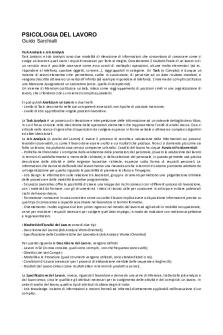
Task Analysis e Job Analysis
- 3 Pages
Popular Institutions
- Tinajero National High School - Annex
- Politeknik Caltex Riau
- Yokohama City University
- SGT University
- University of Al-Qadisiyah
- Divine Word College of Vigan
- Techniek College Rotterdam
- Universidade de Santiago
- Universiti Teknologi MARA Cawangan Johor Kampus Pasir Gudang
- Poltekkes Kemenkes Yogyakarta
- Baguio City National High School
- Colegio san marcos
- preparatoria uno
- Centro de Bachillerato Tecnológico Industrial y de Servicios No. 107
- Dalian Maritime University
- Quang Trung Secondary School
- Colegio Tecnológico en Informática
- Corporación Regional de Educación Superior
- Grupo CEDVA
- Dar Al Uloom University
- Centro de Estudios Preuniversitarios de la Universidad Nacional de Ingeniería
- 上智大学
- Aakash International School, Nuna Majara
- San Felipe Neri Catholic School
- Kang Chiao International School - New Taipei City
- Misamis Occidental National High School
- Institución Educativa Escuela Normal Juan Ladrilleros
- Kolehiyo ng Pantukan
- Batanes State College
- Instituto Continental
- Sekolah Menengah Kejuruan Kesehatan Kaltara (Tarakan)
- Colegio de La Inmaculada Concepcion - Cebu

